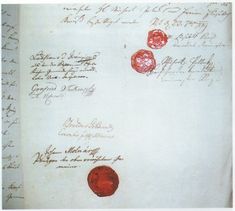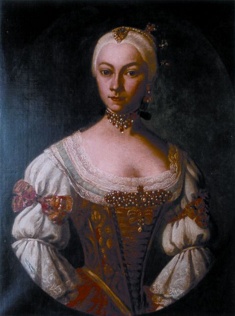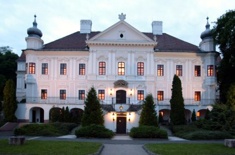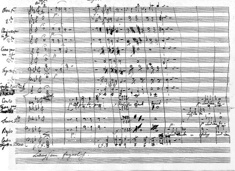|
During the economic crisis that followed the value of the assets of the congregation decreased significantly. Only the offerings by some enthusiastic organisers, who also made sacrifices (Mrs. Beleznay, Mrs. Teleki and Liedemann), helped the congregation to survive this difficult period.
Pollack concluded a contract with the leaders (37), and made new plans for the church. He replaced the Baroque elements by Classicist forms, which resembled churches in Italy. During this period several enthusiastic persons offered donations. Wood, plank and hardware merchants made in-kind donations, rural congregations collected money, and even the Cardinal of Esztergom donated 500 Rhinal Forints and 10,000 bricks. The most generous donation came from Countess Teleki (41), who, from her manor in Szirák
(42) donated two coaches with four-in-hand and one coach with two-in-hand as well as 4,000 Rhinal Forints and 364,000 bricks. |
 (37)
Signatures of the
construction contract
|
|
The foundation stone was laid ceremonially on October 31st 1799. The roof was completed by 1805. Due to financial difficulties and the napoleonic wars however completion suffered repeated setbacks. In 1809 the semifinished building was seized by the military treasury for the purposes of a clothes-making workshop and warehouse, and the building was used for these functions for two years.
At Whitsuntide in 1811 the church was finally consecrated with an abundance of liturgy (43). Superintendent Wächter from Vienna was invited to preach the Word of the Lord in German (44), while minister Simonides preached in Hungarian, and minister Kolozsváry in Slovakian. Bishop Kristóf Lyci performed the consecration ceremony.
The Lord of our congregation blessed the efforts, the joy and woes of an entire quarter of a decade during this high ceremony. Neither Mrs. Beleznay, Mária Podmaniczky, nor Boldizsár Pongrácz, who made serious sacrifices during the planning process of the church, lived to witness that day of joy. However the congregation at the consecration ceremony was fully aware that "their work was not in vain in the name of the Lord"!
Looking at the church building from outside we may see that (contrary to its form today), it also had a spire (45), and in it, until it was pulled down, bells tolled to call the faithful to the church for 6 decades.
Inside the church our attention is drawn to a highly decorated altar (48), the picture of which is an artistic replica by Franz Lochbihler (46) of
Raffaelo's di Santi Transfiguration
 . Dunaiszky built the altar, Countess Teleki donated the marble font, while Baron Prónay donated the pulpit
(47). . Dunaiszky built the altar, Countess Teleki donated the marble font, while Baron Prónay donated the pulpit
(47). After Pollack’s death the leaders of the congregation assigned József Hild, another great architect in Pest, to renovate and re-construct the facade. To the regret of many people the spire, which sat on the roof truss and the beams of the walls had to be pulled down in 1875, and the bells were transported to churches outside Pest.
When our predecessors took possession of the site they acquired in 1792, it was an abandoned area, a cabbage market outside the northern part of the town walls. Now the area is part of the inner city of Budapest.
The whole history of the first Lutheran church in Pest-Buda, which was built on the first stones laid two hundred years ago, is thanksgiving for the providence of the Lord of our congregation, and sincere gratitude for the generous effort of our predecessors. |

(41) Teleki Józsefné Johanna Róth

(42) The castle of Szirák

(43) The song of celebration |